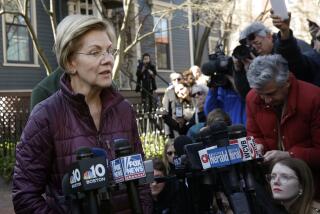Cuomo Sends Quayle Proposal Calling for Fed to Bolster Banks
- Share via
NEW YORK — Gov. Mario M. Cuomo mailed Vice President Dan Quayle a detailed growth plan for the nation’s economy Thursday that included a proposal for the Federal Reserve system to invest up to $25 billion in major banks that agree to make loans to small- and medium-sized businesses.
The Cuomo mailing follows a flap that developed between him and Quayle over the last few days. Cuomo said a letter to Quayle that accompanied the economic plan “says if you really want to be engaged, if you really want to talk, talk about these ideas.”
Quayle, commenting Thursday night during a stop in Chicago, described Cuomo’s letter as “gracious” and said he looked forward to reviewing the governor’s ideas.
Under the Cuomo proposal, banks receiving money from the Federal Reserve would be required to repay the agency after 10 years. Cuomo said the infusion of federal capital could support at least $100 billion in new bank lending.
“Many banks are having trouble making new loans, in part, because they do not have sufficient capital to support new assets,” Cuomo said. “Why not encourage the Federal Reserve to inject capital into our banking system.”
He added: “This wouldn’t be a loan. It would be the Federal Reserve taking an equity position in the banks, which the banks would be required to pay back after 10 years. Unless Washington takes action to strengthen the healthier banks, Washington will end up holding the bag for the bankrupted ones.”
Cuomo told reporters in New York that his letter to Quayle said: “If you don’t like my economic growth plan--fine. What is yours?” Cuomo added that he had signed the letter “Mario.”
Cuomo earlier this week suggested that Quayle’s persistence in referring to him by his first name during an appearance on a nationally televised talk show Sunday was an effort to call attention to the governor’s Italian heritage.
Cuomo also took umbrage at Quayle’s remarks that Republicans would spotlight the “nightmare of New York” if Cuomo seeks the White House. On Wednesday, he referred to Quayle as “Danny,” the “cabin boy” on the Titanic.
Cuomo’s economic plan consists of a broad range of proposals, some of which he had made public piecemeal in various speeches over the last several weeks while he has been trying to decide whether to seek the Democratic presidential nomination.
The plan calls for a federal tax credit for investments in productive equipment and pollution control devices. It also proposes reducing taxes on long-term capital gains and increasing the tax rate on gains earned in less than a year to encourage certain types of investments.
“Such reform should be targeted so that the new low rate--of say 10%--would apply only to new and productive investments, not investments in land, art or collectibles,” Cuomo said.
Cuomo’s plan also proposes raising the federal research and development tax credit to 30% from the existing 20%.
It also suggests that the Bush Administration help financially strapped cities and states through legislation that would help finance high speed rail systems and highways equipped with electronic gear that monitors and regulates traffic flow.
To improve the nation’s labor pool, the plan proposes that the federal government join states in developing apprenticeships for students not bound for college. And it recommends an expansion of an existing program that provides financial assistance for college students.
To help finance the various proposals, the plan calls for shifts in national budget priorities that would result in cutting military spending by at least $85 billion over five years.
The plan also proposes increasing taxes on people earning more than $200,000 a year. And it says that the Internal Revenue Service should “go after the tens of billions of dollars that foreign governments owe the U.S. Treasury.”
Cuomo’s plan calls on the President to use the prestige of his office to ask “the greatest corporations in the country and some foreign investors” to speed up any plans they have to invest in capital projects in America. It suggests that these investments total between $50 million to $100 million apiece.
More to Read
Get the L.A. Times Politics newsletter
Deeply reported insights into legislation, politics and policy from Sacramento, Washington and beyond. In your inbox twice per week.
You may occasionally receive promotional content from the Los Angeles Times.










